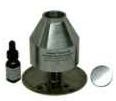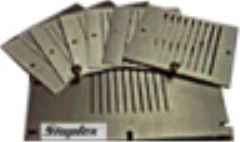|
|
|
|
||||||||||||||||||||||||||||||||||||||||||||||
|
|
||||||||||||||||||||||||||||||||||||||||||||||
  Annular Kinetic Impactors and High Volume Cascade Impactors, 4, 5 & 6 Stage modelsStaplex® Model AKI Annular Kinetic Impactor
Specifications: Staplex Model
AKI Required Accessories: Description and Applications The Staplex® Model AKI Annular Kinetic Impactor, an inertial collector, was developed for use with Staplex® Models TFIA, TFIA-2 and TFIA-4 High Volume Air Samplers and allied instruments for collection sampling of large airborne radioactive particles at high sampling rates for industrial plants, nuclear power installations, air pollution surveys, mining and storage facilities, laboratories, governmental and health care organizations. The Impactor head is designed for sampling alpha, beta, and gamma-emitting contaminants, plutonium fission, and radon decay products. In particular, it collects airborne particles containing alpha-emitting radioactive elements such as plutonium, without collecting the co-existing particles containing radon and thoron products. Thus the sample can be counted quickly without waiting six to twenty-four hours for the daughter activity to decay, thereby eliminating the necessity of decay analysis. Principle of Operation In most cases, airborne radioactivity is associated with large, dense particles. Radon and thoron daughter activity is associated with extremely small particles. The two populations overlap only slightly. With a Staplex Annular Kinetic Impactor, the air to be sampled enters the annular space at the rear, makes a 180 degree turn at the collecting disk at the front and is drawn out through the center tube. The larger particles cannot negotiate the turn and impact on the greased collecting disk. The size of the particles which will be impacted on the collecting disk can be varied by adjusting the slit width and velocity of air flow. For a given slit width, the minimum particle diameter, D, for which the impaction efficiency is 100% may be computed from the equation. (Contact Staplex at info@staplex.com for AKI literature sheet and details) Sampling for a ten minute period will detect the maximum permissible concentration of alpha, beta, and gamma-emitting contaminants. Collection efficiency for these contaminants will be approximately 95%. This compares favorably with the 98% efficiency of Staplex® TFA41 filter paper. The collection efficiency for radon decay products is approximately 5% for the impactor. The Impactor is capable of sampling air at a rate of 50 cubic feet per minute (CFM), which corresponds to an orifice velocity of 454 linear feet per minute. Theoretical calculations indicate that this Impactor should impinge on the sampling disk all particles down to 0.4 micron in diameter which have densities greater than 15 gm/cm3 Technical Description Collection efficiencies for particles within the range of the Impactor were determined by connecting two Staplex® Impactors in series. The efficiency of the collecting material used to trap the particles is obtained from the ratio of the activities deposited on each sampling disk. The following collection efficiencies were obtained in various types of contaminated atmospheres when using Staplex® SF200 Fluid (coating grease):
The collection efficiency is constant up to a sampling time of twenty minutes. Longer sampling periods cause a decrease in collection efficiency due to the dust particles covering the surface of coating grease. Self-absorption of alpha activity in the coating grease will be approximately 55.4 per cent with a standard deviation of 19. The beta self-absorption indicates beta activity lost in the grease to be less than 5.0 per cent with a standard deviation of 3.3. A particle size study of the active particles removed by the Impactor indicates that 89 per cent of the active particles are above one micron in diameter and 11 per cent below. The majority of the particles (52 per cent) are between one and five microns which is the size range most likely to be retained by the alveoli.
Staplex® Model 234
(4 stage)
|
||||||||||||||||||||||||||||||||||||||||||||||
|
Stage No |
40CFM |
20 CFM |
| 1 | 7.2 | 10.2 |
|
2 |
3.0 |
4.2 |
|
3 |
1.5 |
2.1 |
|
4 |
0.95 |
1.4 |
|
5 |
0.49 |
0.73 |
|
6 |
--- |
0.41 |
|
Hi Vol Filter |
0 |
0 |
SPECIFICATIONS:
Meets all U.S. E.P.A. Federal Reference Methods Standards.
Flow rate: Model 235: 1.13 SCMM (40 SCFM) nominal. 0.5-1.5 SCMM
(20-50 SCFM) range
Model 236: 0.56 SCMM (20 SCFM) nominal: 0.3-0.7 SCMM
(10-25 SCFM) range
Material: - Anodized aluminum alloy, precision machined
Overall Size (Model 235) - 23.5 cm W x 30.5 cm L x 5.1 cm H (9.25 x 12 x 2);
Impactor stages: 15.2 cm W x 17.8 L (6 x 7)
Net Weight (Model 235) - 2.5 kg (5.5 lbs.)
| Staplex® Model | Description |
| 234 | 4 Stage High Volume Cascade Impactor |
| 235 | 5 Stage High Volume Cascade Impactor |
| 236 | 6 Stage High Volume Cascade Impactor |
Collection Media -
Staplex® Slotted Media for use between each impactor stage. Size: 14.3 cm x 13.7 cm (5.63 in. x 5.38 in.)
TFAS810 Slotted Cellulose Filters (25 per box)
TFAGFS810 Slotted Glass Fiber Filters (25 per box)
TFAQS810 Slotted Quartz Fiber Filters (25 per box)
Staplex® High Volume Back Up Media for use after last stage. Size: 8x10
TFA810 Cellulose Filter Paper (100 per box)
TFAGF810 Glass Fiber Filters (100 per box)
TFAQ810 Quartz Filters (25 per box)
The Staplex Company, Inc. All rights reserved. Staplex, the Staplex logo, AccuSlitter and the AccuSlitter logo, Tabster and the Tabster logo are registered trademarks of The Staplex Company, Inc. Patented and patent pending items. Specifications and availability subject to change without notice or obligation.
 For
sampling Alpha, Beta and Gamma emitting contaminants,
Plutonium fission and radio decay products
For
sampling Alpha, Beta and Gamma emitting contaminants,
Plutonium fission and radio decay products for
use with Staplex® TFIA Series High Volume Air Samplers
for
use with Staplex® TFIA Series High Volume Air Samplers